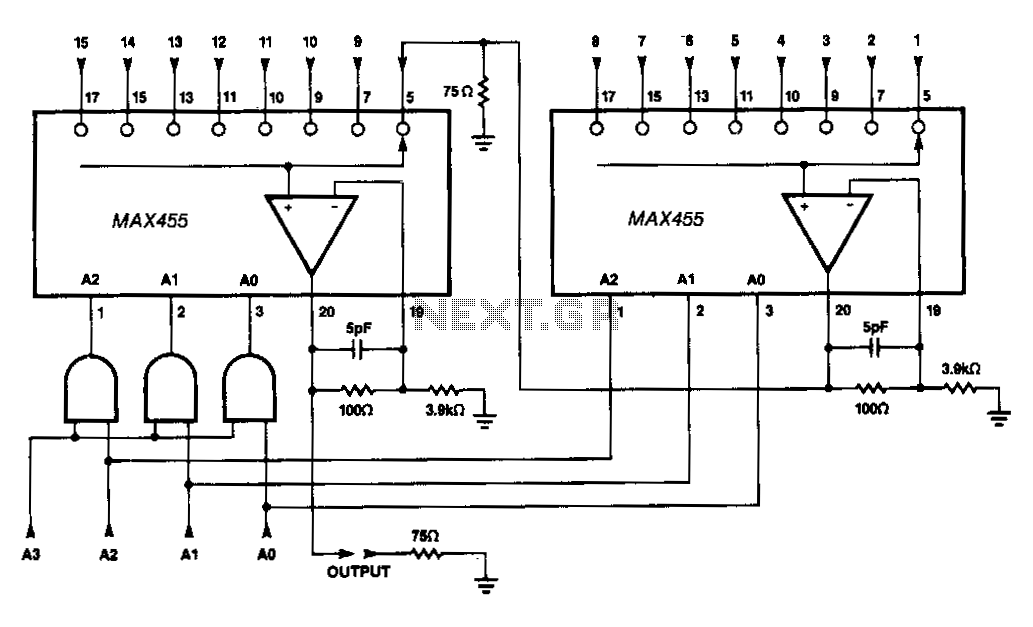
10F15-cascaded-video-mux

Two MAX455s can be cascaded to create a 1 of 15 video multiplexer (MUX) by connecting the output of one MUX to one of the input channels of a second MUX. Although the two devices are typically placed close together, the output of the first MUX should be terminated to maintain its bandwidth.
The MAX455 is a high-speed analog multiplexer designed for video and other high-frequency applications. When cascading two MAX455 devices to achieve a 1 of 15 video MUX configuration, the output of the first MUX is connected to one of the input channels of the second MUX. This configuration allows for the selection of one of fifteen different video signals, enabling a versatile switching mechanism for video applications.
To ensure optimal performance, it is crucial to terminate the output of the first MUX properly. This termination helps to preserve the bandwidth and signal integrity of the video signal being processed. Typically, a resistor matching the characteristic impedance of the transmission line is used for termination. For example, if the system is designed for a 75-ohm video signal, a 75-ohm resistor should be connected to the output of the first MUX.
In the schematic design, it is essential to consider the layout of the circuit to minimize signal degradation. The two MAX455 devices should be placed in proximity to reduce the effects of parasitic capacitance and inductance. Proper grounding and power supply decoupling techniques should also be implemented to ensure stable operation and minimize noise.
The cascading of the MAX455 devices allows for a high degree of flexibility in video routing applications, making it suitable for use in professional video equipment, broadcast systems, and other high-performance video processing environments. Careful attention to the design details will contribute to the overall reliability and performance of the video MUX system.Two MAX455s can be cascaded to form a 1 of 15 video MUX by connecting the output of one MUX to one of the input channels of a second MUX. Although the two devices are usually close to one another, the output of the first MUX should be terminated to preserve its bandwidth.
The MAX455 is a high-speed analog multiplexer designed for video and other high-frequency applications. When cascading two MAX455 devices to achieve a 1 of 15 video MUX configuration, the output of the first MUX is connected to one of the input channels of the second MUX. This configuration allows for the selection of one of fifteen different video signals, enabling a versatile switching mechanism for video applications.
To ensure optimal performance, it is crucial to terminate the output of the first MUX properly. This termination helps to preserve the bandwidth and signal integrity of the video signal being processed. Typically, a resistor matching the characteristic impedance of the transmission line is used for termination. For example, if the system is designed for a 75-ohm video signal, a 75-ohm resistor should be connected to the output of the first MUX.
In the schematic design, it is essential to consider the layout of the circuit to minimize signal degradation. The two MAX455 devices should be placed in proximity to reduce the effects of parasitic capacitance and inductance. Proper grounding and power supply decoupling techniques should also be implemented to ensure stable operation and minimize noise.
The cascading of the MAX455 devices allows for a high degree of flexibility in video routing applications, making it suitable for use in professional video equipment, broadcast systems, and other high-performance video processing environments. Careful attention to the design details will contribute to the overall reliability and performance of the video MUX system.Two MAX455s can be cascaded to form a 1 of 15 video MUX by connecting the output of one MUX to one of the input channels of a second MUX. Although the two devices are usually close to one another, the output of the first MUX should be terminated to preserve its bandwidth.